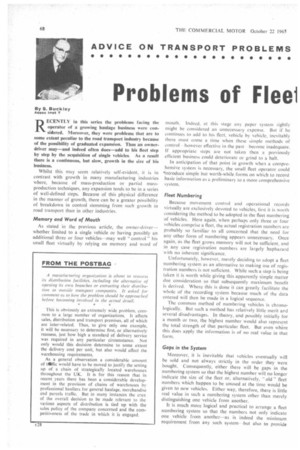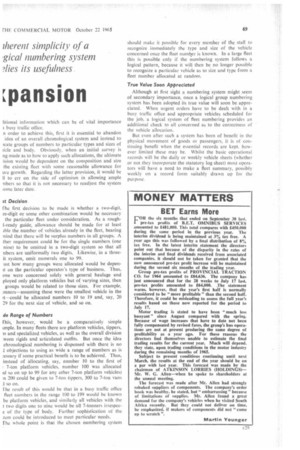Problems of Fleel pansion
Page 70

Page 71

Page 72

If you've noticed an error in this article please click here to report it so we can fix it.
RECENTLY in this series the problems facing the operator of a growing haulage business were considered. Moreover, they were problems that are to some extent peculiar to the road transport industry because of the possibility of graduated expansion. Thus an ownerdriver may—and indeed often does—add to his fleet step by step by the acquisition of single vehicles. As a result there is a continuous, but slow, growth in the size of his business.
Whilst this may seem relatively self-evident, it is in contrast with growth in many manufacturing industries where, because of mass-production or partial massproduction techniques, any expansion tends to be in a series of well-defined steps. Because of this physical difference in the manner of growth, there can be a greater possibility of breakdown in control stemming from such growth in road transport than in other industries.
Memory and Word of Mouth As stated in the previous article, the owner-driver-whether limited to a single vehicle or having possibly an additional three or four vehicles--may well " control " his small fleet virtually by relying on memory and word of
mouth. Indeed, at this stage any paper system rightly might be considered an unnecessary expense. But if he continues to add to his fleet, vehicle by vehicle, inevitably there must come a time when these simple methods of control --however effective in the past become inadequate. If appropriate steps are not taken then a previously efficient business could deteriorate or grind to a halt.
In anticipation of that point in growth when a comprehensive system is necessary, the small fleet operator could 'introduce simple but worth-while forms on which to record basic information as a preliminary to a more comprehensive system.
Fleet Numbering
Because movement control and operational records virtually are exclusively devoted to vehicles, first it is worth considering the method to be adopted in the fleet numbering of vehicles. Here again, when perhaps only three or four vehicles comprise a fleet, the actual registration numbers are probably so familiar to all concerned that the need for any other form of numbering appears unnecessary. Once again, as the fleet grows memory will not he sufficient, and in any case registration numbers are largely haphazard with no inherent significance.
Unfortunately, however, merely deciding to adopt a fleet numbering system as an alternative to making use of registration numbers is not sufficient. While such a step is being taken it is worth while giving this apparently simple matter due consideration so that subsequently maximum benefit is derived. Where this is done it can greatly facilitate the whole of the recording system because much of the data entered will then be made in a logical sequence.
The common method of numbering vehicles is chronologically. But such a method has relatively little merit and several disadvantages. In theory, and possibly initially for a month or two, the highest number would also represent the total strength of that particular fleet. But even where this does apply the information is of no real value in that form.
Gaps in the System Moreover, it is inevitable that vehicles eventually will be sold and not always strictly in the order they were bought. Consequently, either there will be gaps in the numbering system so that the highest number will no longer indicate the size of the fleet or, alternatively, "old" fleet numbers which happen to be unused at the time would be given to new vehicles. Either way, therefore, there is little real value in such a numbering system other than merely distinguishing one vehicle from another.
It is much more logical and practical to arrange a fleet numbering system so that the numbers not only indicate one vehicle from another—as is indeed the minimum requirement from any such system but also to provide litional information which can be of vital importance busy traffic office.
n order to achieve this, first it is essential to abandon idea of an overall chronological system and instead to vale groups of numbers to particular types and sizes of iicle and body. Obviously, when an initial survey is ng made as to how to apply such allocations, the ultimate ;ision would be dependent on the composition and size the existing fleet with some reasonable allowance for ure growth. Regarding the latter provision, it would be Li to err on the side of optimism in allowing ample libel's so that it is not necessary to readjust the system ;onie later date.
st Decision the first decision to be made is whether a two-digit, ee-digit or some other combination would be necessary the particular fleet under consideration. As a rough1-ready guide, allowance should be made for at least tble the number of vehicles already in the fleet, bearing -nind that there will be surplus numbers in all groups. A. ther requirement could be for the single numbers (one nine) to be omitted in a two-digit system so that all nbers are uniformally two digits. Likewise, in a threeit system, omit numerals one to 99.
ust how many groups were allocated would be depenit on the particular operator's type of business. Thus, one were concerned solely with general haulage and ployed only platform vehicles but of varying sizes, then groups would be related to those sizes. For example, Dianers—assuming these were the smallest vehicle in the A—could be allocated numbers 10 to 19 and, say, 20 29 for the next size of vehicle, and so on.
de Range of Numbers
This, however, would be a comparatively simple tmple. In many fleets there are platform vehicles, tippers, is and specialized vehicles, as well as the overall division ween rigids and articulated outfits. But once the idea chronological numbering is dispensed with there is no
objections to using as wide a range of numbers as is ;essary if some practical benefit is to be achieved. Thus, instead of allocating, say, number 10 to the first of 7-ton platform vehicles, number 100 was allocated id so on up to 99 for any other 7-ton platform vehicles) ,rti 200 could be given to 7-ton tippers, 300 to 7-ton vans so on.
The result of this would be that in a busy traffic office fleet numbers in the range 100 to 199 would be known be platform vehicles, and similarly all vehicles with the t two digits one to nine would be all 7-tonners irrespece of the type of body. Further sophistication of the tern could be introduced to meet particular needs.
The whole point is that the chosen numbering system should make it possible for every member of the staff to recognize immediately the type and size of the vehicle concerned once the fleet number is known. In a large fleet this is possible only if the numbering system follows a logical pattern, because it will then be no longer possible to recognize a particular vehicle as to size and type from a fleet number allocated at random.
True Value Soon Appreciated Although at first sight a numbering system might seem of secondary importance, once a logical group numbering system has been adopted its true value will soon be appreciated. When urgent orders have to be dealt with in a busy traffic office and appropriate vehicles scheduled for the job, a logical system of fleet numbering provides an additional check to all concerned as to the correctness of the vehicle allocation.
But even after such a system has been of benefit in the physical movement of goods or passengers, it is of continuing benefit when the essential records are kept. however limited these may be. Whilst the basic operational records will be the daily or weekly vehicle sheets (whether or not they incorporate the statutory log sheet) most operators will have a need to make a fleet summary, possibly weekly on a record form suitably drawn up for the purpose.
But first, at this stage, it is convenient to consider briefly the drawing up of a daily vehicle sheet and it is assumed that most operators will wish to combine the daily vehicle records sheet with the statutory log sheet. As the date and vehicle number would be the chief distinguishing feature between one such sheet and another, the daily sheet should be so drawn up that this information is entered at the right top corner. Immediately below would be entered the name of the driver (and attendant if any) followed by the required information as to the date and time last ceased work, time started work, intervals of rest, time ceased work and total time worked.
Particulars of Journeys Recorded
Underneath this there would be recorded particulars of journeys made and goods carried. According to the type of trade in which the vehicle was employed, provision would be made to record the amount in units or weight of the traffic moved, with space for the appropriate total at the bottom of the sheet. Although not legally required, many operators find it convenient to record mileometer readings and amount of fuel issued. All the information so far would occur daily, but many operators may wish to record particulars of delays and breakdowns and this can be done on the reverse side of the sheet. bearing in mind that this would be used only occasionally.
Chance of Error Reduced
If at the end of the week the several daily vehicle sheets were checked and then placed in order, then where a logical fleet numbering system applied entry of the totals from these sheets on to a weekly summary sheet would automatically list the vehicles in their appropriate groups according to size of vehicle and type of body. The headings on the weekly summary sheet would follow the same sequence of columns as was arranged on the daily vehicles sheet. This would facilitate the transfer, of data from one sheet to the other and reduce the possibility of introducing error in the process.
Because the vehicles would then appear in their respective groups on the summary sheets it would be a relatively easy matter to obtain, for example, fuel consumption averages for each group as well as for the entire fleet. By so doing a yardstick would be provided by which to measure the performance of any particular vehicle against that for its own group and under the same operational conditions that might apply that particular week.
















































































































